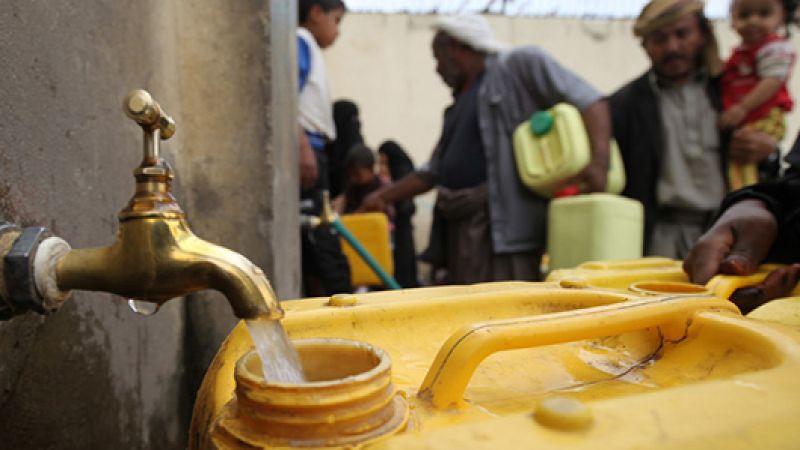
By Brett Sudetic
On December 23, the Syrian government launched an assault to retake the rebel-held town Wadi Barada, a small enclave near the Lebanese border northwest of Damascus. Clashes erupted between regime forces and Syrian rebels, which led to the regime’s targeting of the Ain Al-Fija Spring, the region’s most important source of water. The spring supplies more than 5.5 million residents of the greater Damascus region. Both sides were accused of deliberately targeting the spring in the fighting, which led to three days of severe water shortages that affected millions of the city’s residents.
The targeting of the Ain Al-Fija Spring demonstrates an issue of growing concern in the Middle East: the combination of scarce water resources and conflict. The Syrian crisis itself has led to the displacement of millions of people throughout the country and the region, with many Syrians unable to meet the most basic of their needs. To mitigate further conflict and reduce human suffering in the Middle East, the international community, including the United States, must ensure that vital water resources are protected in conflict zones in the region.
Water has always been a dimension of global conflicts. However, water resources in the Middle East, given the region’s dry climate and multiple, ongoing crises, are more vulnerable to becoming an element of conflict. Even without the presence of conflict, countries in the region, which contain five percent of the world’s population, but only one percent of its renewable water resources, are severely threatened by scarce water resources. Climate change, misuse of water resources, and disagreements between countries laying claim to the same water resources exacerbate this phenomenon.
The US Intelligence Community has highlighted the danger that limited water resources pose to global security. A 2012 report from the Office of the Director of National Intelligence (DNI) identified the Jordan, Tigris-Euphrates, and Nile river basins – all in the Middle East – as some of the areas most threatened by water scarcity. The report indicated that water scarcity could lead to greater conflict, especially without implementation of clear agreements between communities and nations. Yemen provides a clear example where this has happened.
Yemen has some of the most threatened water resources on earth. The country has increasingly faced challenges with water management and decreasing water supply. The limited freshwater that does exist in Yemen primarily comes from non-renewable groundwater sources, much of which is poorly managed or used to grow Qat, a tobacco-like stimulant... Some estimates indicate that the capital city of Sanaa’ could run out of water by the end of 2017.
The ongoing conflict between Houthi revolutionaries and the Saudi-allied Yemeni regime makes the situation in the country, which is already deprived of sufficient water resources, even worse. Bombardment and indiscriminate shelling threaten Yemen’s critical water infrastructure, including pipelines, treatment facilities, and groundwater wells. If the Yemeni government and Arab coalition led by Saudi Arabia are unable to protect water assets, the severe humanitarian crisis in the country will only worsen.
The international community, while seeking a peaceful political resolution to the conflict, should also provide technical and financial support to strengthen the resiliency and security of the minimal water resources that remain in Yemen. Additionally, Saudi Arabia and the Arab Coalition, made up of other Gulf Cooperation Council countries, should ensure that vital water infrastructure, including dams, pipelines, and treatment centers, are protected from aerial bombardment and on-the-ground clashes. Precautions like this could reduce the number of refugees and internally displaced persons produced by the conflict.
The conflicts in Syria and Yemen demonstrate the need for the international community and western powers, which possess both technical know-how in water resource management and abundant aid funding, to help countries in the region provide water to their populations. The United Nations and countries like the United States must address the issue of water scarcity in order to lessen the impact of humanitarian crises caused by conflicts in Syria, Iraq, Yemen, and Libya.
Fortunately, government agencies like the United States Agency for International Development (USAID) and the United Nations’ Development Programme (UNDP) are working to secure these resources by helping to increase water supplies, bolster efficiency, and educate local populations on water scarcity and sustainability. USAID currently assists a number of countries in the Middle East and North Africa, including Jordan, Morocco, Tunisia, and Lebanon with water and sanitation projects.
While these organizations should continue to provide this support, they must also expand their programs to more countries in the region whose water resources are directly affected by armed conflict. Without such attention, humanitarian crises in the region will only increase in severity as the region’s populations struggle to obtain critical freshwater resources.
Source: The Huffington Post, Edited by Website Team